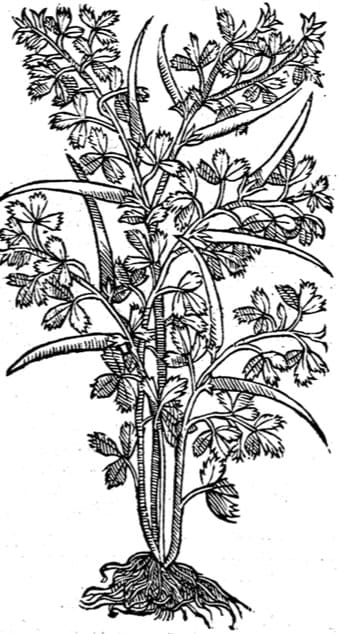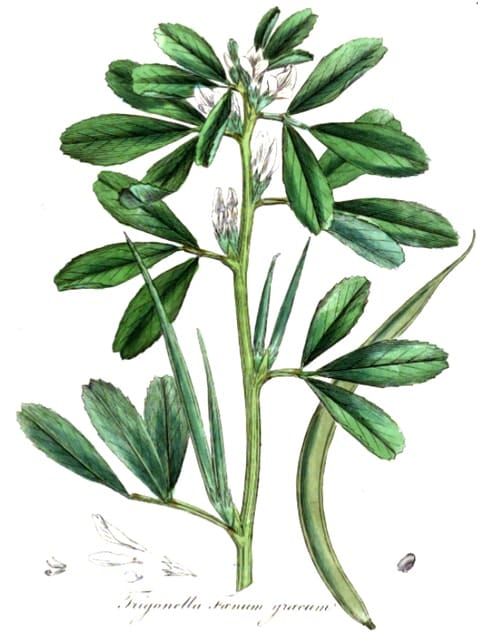Trigonella, Fenugreek, Hu Lu Ba 葫芦巴Also called Foenum GraecumHu Lu Ba (TCM) Hulba (Unani) Methi (Ayurveda) |

|

|

|

|
|
Dioscorides Materia Medica, Mathias, 1563 |
Medical Botany, Woodville, Hooker, Vol. 3, 1832 |
 Members CLICK HERE for the PRO VERSION
Members CLICK HERE for the PRO VERSIONBotanical name:
Trigonella foenum-graecum
Parts used:
Seed
Temperature & Taste:
Warm, dry. Pungent, Bitter
mollifies, discusses
Classifications:
2B ATTENUATER. 2G. CLEANSING. 2J. RAREFYING. 2L. EMOLLIENT. 2Q. ANODYNE. 2U. SUPPURATIVE. 2V. EXPEL PUS
2W. SARCOTIC
3L. ANTI-TUSSIVE
4d. PECTORAL. 4f. SPLENETIC. 4j. NERVINE
Laxative, Purgatives and Cathartics
Uses:
1. Warms and Strengthens the Kidneys: (TCM, West, Ayurveda, Tibetan)
-Cold and Weak Kidneys with Lower Back Pain
-Edema, Fluid Retention
-Lumbago, Arthritis, Rheumatism, Sciatica
-Diabetes
2. Strengthens the Lungs, clears Phlegm, stops Cough: (West, Ayurveda)
-Cold-Phlegm type Cough and Wheezing, either acute, or chronic with Deficiency
-acute sore Throat, Tonsillitis
-Cough, Bronchitis, Asthma, Emphysema, Tuberculosis
3. Strengthens the Spleen, Increases Qi: (West, Ayurveda, Tibetan)
-increases appetite and digestion
-increases strength and body weight
-convalescence, chronic illness, debility, anemia
4. Moistens the Intestines: (West, Ayurveda)
-gentle, soothing laxative
-inflammation of the Stomach or Bowels; Gastritis, Dysentery
5. Moves the Blood, Promotes Menstruation: (West)
-Amenorrhea and Dysmenorrhea associated with Cold
-traditionally to increase Breast size and give a more shapely body to women
-“Fenugreek dissolves Phlegmatic and Hard Swellings”. (Avicenna)
6. Promotes and Enriches Breast Milk: (West, Ayurveda)
-nourishes Breast Milk, increases quality and quantity
7. Externally:
-commonly used in Enemas and Douches
-douche, wash, sitz-bath or suppository is good for Abscesses, Ulcers, Hardness, Swellings, Inflammations and Obstructions of the Uterus and to soften all hard Tumors of it.
-“Used as a pessary with duck fat to cure hardness of Uterus”. (Avicenna)
-externally for Cold type skin eruptions, Wounds, Tumors, Abscesses, Boils, Swollen Glands, Scrofula, Sores
-“It softens and matures Abscesses” (Avicenna)
-topically for Pain and Inflammation in plasters and fomentations
-decoction as a wash for strong underarm odor (Pliny)
-decoction is used as a wash for Dandruff
-“used in Freckles, [and for] improvement of Complexion”. (Avicenna)
-“The oil of Fenugreek, obtained with Myrtle, is useful for the Hair and also for removing the Scars.” (Avicenna)
-“Its mucilage is usefuI in (skin) Ruptures attributed to Cold exposure, particularly when used with rose oil”. (Avicenna)
Dose:
Pliny noted that prolonged boiling reduces its bitterness.
Decoction: 4½–9 grams
Powder: 1–4 grams
Used topically in plasters, oils and as a mucilage.
Correctives:
… available in PRO version
Substitutes:
… available in PRO version

Main Combinations:
1. Cold and Moist Cough, Fenugreek with … available in PRO version
2. Sore Throat, Tonsillitis, Fenugreek with … available in PRO version
3. Scarlet Fever, Fenugreek with … available in PRO version
4. To clear Phlegm, Fenugreek with … available in PRO version
5. To increase Milk, Fenugreek with … available in PRO version
6. Cold-type Hernia, Fenugreek with … available in PRO version
7. Hard Swellings, Tumors, Scrofula:
i. topically Fenugreek with … available in PRO version
ii. topically Fenugreek with … available in PRO version
Major Formulas:
Decoction for Asthma (Zacharia)
Tragacanth Warming Powder (Pulvis Diatragacanth Calidii) (Nicholas)
A Sound and Experienced Electuary (Mesue)
Confection for Cold Cough
Troches for Pleurisy when not from Vehement Heat
Ointment of Marshmallow (Nicolas)
Cautions:
1. Not used (alone) for Heat or Fever, especially Deficient Heat
2. Not used during Pregnancy
Main Preparations used:
Mucilage
History
|
‘In the old Egyptian preparation Kyphi, an ingredient “Sebes or Sebtu ” is mentioned, which is thought by Ebers to mean fenugreek. This plant was well known to the Roman writers on husbandry, as Porcius Cato (B.C. 234-149) who calls it Foenum Graecum and directs it to be sown as fodder for oxen. It is the [?] of Dioscorides and other Greek writers. Its mucilaginous seeds, “siliquae” of the Roman peasants, were valued as an aliment and condiment for man, and as such are still |
largely consumed in the East. They were likewise supposed to possess many medicinal virtues, and had a place in the pharmacopoeias of the last century. The cultivation of fenugreek in Central Europe was encouraged by Charlemagne (A.D. 812), and the plant was grown in English gardens in the 16th century.’ (Pharmacographia, Fluckiger & Hanbury, 1879) |
|
‘Fenugreek has a history of great antiquity; it was much valued by the ancients both as a food and medicine; in India it has long been extensively cultivated, its seeds being considered carminative, tonic, and aphrodisiac. Several confections made with them are described in Sanskrit works under the names of Methi modaka, Svalpa methi modaka, &c, and are recommend-ed for use in dyspepsia with loss of appetite, in the diarrhoea of puerperal women, and in rheumatism. All these preparations consist of a number of aromatic substances, one part each, and fenugreek seeds equal in quantity to all the other ingredients. Under the Arabic name of Hulbah, Mahometan writers describe the plant and seeds as hot and dry, suppurative, aperient, diuretic, emmenagogue, useful in dropsy, chronic cough and enlargements of the spleen and liver. A poultice of the leaves is said to be of use in external and internal swellings and burns, and to prevent tho hair falling off. The flour of the seeds is used as a poultice, and is applied to the skin as a cosmetic. They also use the oil of the seeds for various purposes. In Europe the history of the plant is equally ancient. |
Aretaeus prescribed it both internally and externally. The powder of the seeds was recommended by Dioscorides in the form of a poultice for inflammatory affections. Pliny mentions its various uses as a medicine. Ainslie notices its uses by native practitioners in Southern India for dysentery, the seeds being toasted and afterwards infused. At the present time, Fenugreek is extensively used in India both as an article of diet and as a medicine. The young plants are always to be found in the vegetable markets, and are most esteemed when only the two seed leaves are formed; they are boiled and afterwards fried in butter, the taste is strongly bitter, and disagreeable to those who have not become accustomed to it; in bilious states of the system the vegetable has an aperient action. The seeds form the basis of a medicinal confection extensively used by the natives. They also enter into the composition of an imitation of carmine. The yellow decoction used with sulphate of copper produces a fine permanent green. In the Concan the leaves are used both internally and externally on account of their cooling properties’. (Vegetable Materia Medica of Western India, Dymock, 1885) |
